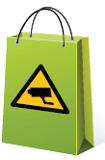
Covering All Ground
Video surveillance stays on guard at shopping centers
- By Mig Paredes
- Aug 01, 2009
New video surveillance technologies reduce
mall managers' dependence on costly security
guards, minimize false alarms and capture important
details. Although theft is an important reason to
have a video system, it is not the only issue for a shopping
center.
Video also eliminates the payouts of fraudulent slips
and falls, a major liability concern of retail outlets. It lets
shoppers know they are protected, which is why so many
mall operators prioritize the parking lot when developing
their video systems. Managers and security staff also can
use the cameras to spot traffic tie-ups or other problems
in and around the mall.
Typical Shopping Mall Video Systems
Dome cameras are strategically placed to cover all common
areas. In most cases, the dome system switches automatically
between a color mode for daytime use and a
more sensitive monochrome made for nighttime viewing.
This lets one camera provide around-the-clock surveillance,
reducing equipment and maintenance costs. Fixed
cameras are typically used in various service areas, including
loading docks, restrooms and emergency exits.
In addition to increasing security, mall managers
often use the system to monitor essential areas and ensure
certain mall operations are running smoothly. For
example, cameras can watch cleaning crews and staff to
maintain the integrity of the mall, fixed cameras placed
at escalators minimize liability issues, and a camera in
front of the mall monitors the valet service and ensures
streets are kept clear.
Cameras also can record cars entering and exiting
while monitoring parking deck capacity. If a car needs
to be towed, records show whether the car has been there
for five minutes or an hour. In the event of an incident,
staff also can zoom in on a license plate.
With a surveillance system and a digital DVR, the
manager in the back office can view any camera or play
back any image at any time, as well as send images over
the Internet.
With traditional cameras, outdoor details can often be
overpowered by bright light, making it difficult for security
personnel to see inside trucks at loading docks or what's
going on inside an entrance. Headlights make it nearly impossible
to see license plates in the parking deck.
New digital cameras display perfect picture quality
equal to the human eye. For example, motion adaptive
DNR takes dark images and makes them clear. Digital
image stabilization removes the blurs of motion, providing
a crisp still image. Today's digital cameras also incorporate
a low-light noise-reduction and color-suppression
function. Their extended dynamic range feature corrects
the problems of darkness and brightness, which render
images unreadable. Wide dynamic range provides clear
images even under backlight, removing glare problems.
Such technology increases exposure in shadowed areas
and decreases exposure in bright areas, delivering a
light-corrected image that shows crucial details clearly.
It even adjusts for different lighting conditions within the
same image.
While ordinary surveillance cameras are affected by
glare, refl ections, backlighting and shadows that obscure
important details, new camera technologies let users see
everything. When installed in a mall lobby, security staff
can see clear images of people's faces, even if the afternoon
sun or bright refl ections shine right into the camera.
Megapixel Cameras in Entrances, Parking Lots
If the main goal of a camera is to capture a face at the
entrance or a license plate in the parking lot, its objective
is to produce a clear image. Without clarity, neither
facial nor license plate recognition software can be effective.
That is why most shopping centers are selecting
megapixel cameras, which provide higher-resolution
progressive-scan images, instead of analog PTZ, which
provide lower-resolution interlaced-scan images, or even
standard digital IP PTZ cameras, for these locales.
The picture quality advantages of megapixel network
cameras benefit shopping centers in several ways. In
some applications, a megapixel network camera can cover
the same area as other cameras but with an improved
level of picture quality. For instance, almost everyone
is familiar with images captured by CCTV systems in
which the quality is so poor that little can be determined
from the recording and, all too often, no positive identification is possible.
Megapixel network cameras solve this disadvantage
by producing increased resolution and clarity. For example,
a high-resolution analog camera provides a resolution
of 704x480 while the megapixel camera provides a
resolution of 1,280x1,024, a significant difference.
In other applications, megapixel cameras cover a
wider area than standard CCTV cameras. This means
a shopping center can install a megapixel camera with
four times the resolution of a standard camera or even a
3.1 megapixel camera with 10 times the resolution of a
standard camera.
Shoppers Want to Know They Are Safe
To alert workers and shoppers that a surveillance system
is watching over them, many shopping centers display
live video on a large screen, which allows people to see
themselves on the monitor. A video wall is easy to set up
and can be used for multiple purposes.
When not showing surveillance video, these monitors
can display a variety of advertising and multimedia messages.
These professional monitors differ from standard
TVs because their screen protection techniques can display
information without the possibility of screen burn.
Leveraging the Advantages of Remote Monitoring
By tying a surveillance system into the Internet, a shopping
center can share its video with the local police and allow
authorities to access certain cameras, as well as PTZ from
dispatch, and respond quickly when needed. In other cases
in which remote monitoring is not an option, shopping
center security staff can send video to
the police so they can respond quickly,
knowing exactly where they have to go
and with what they are dealing with.